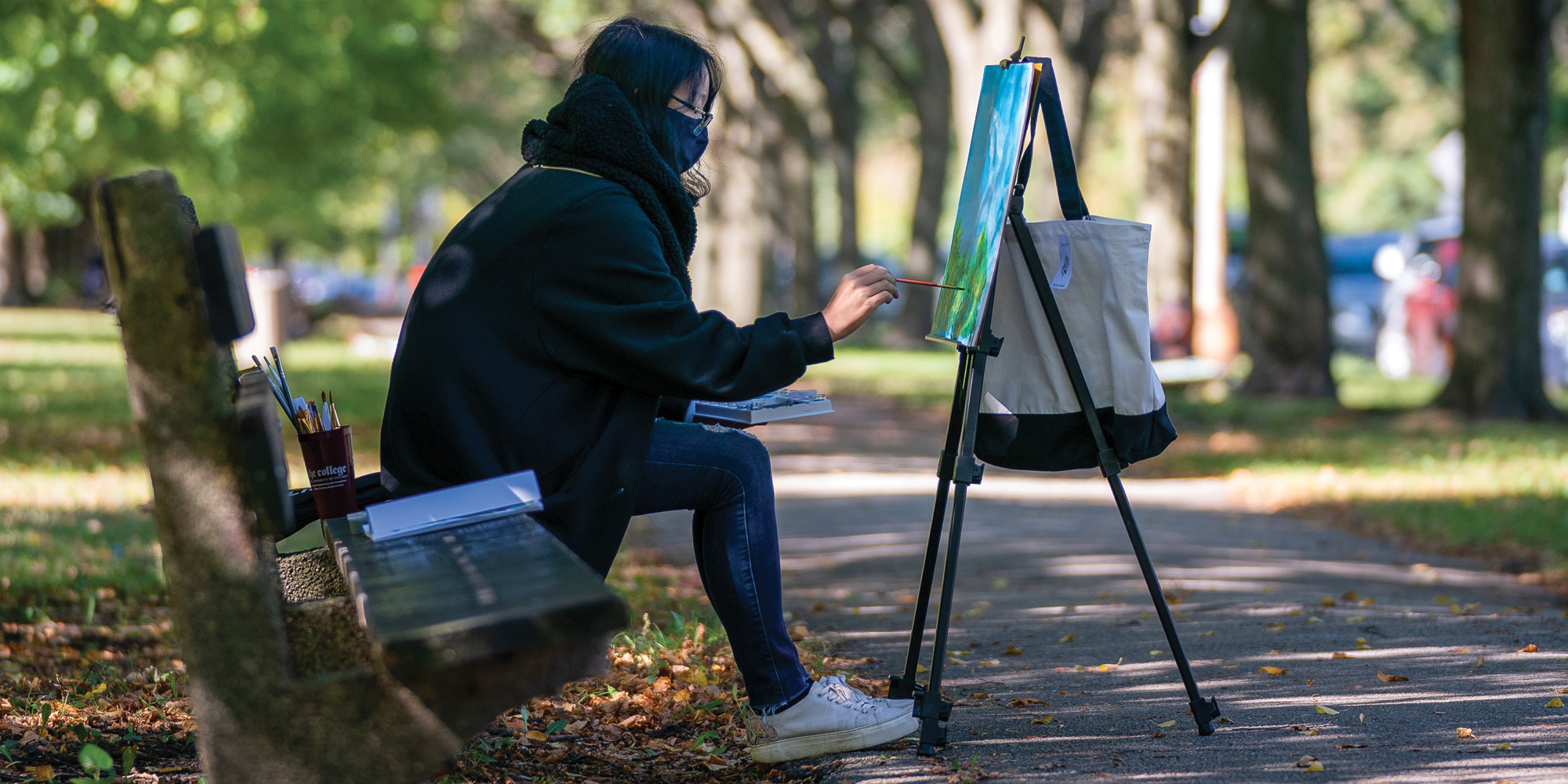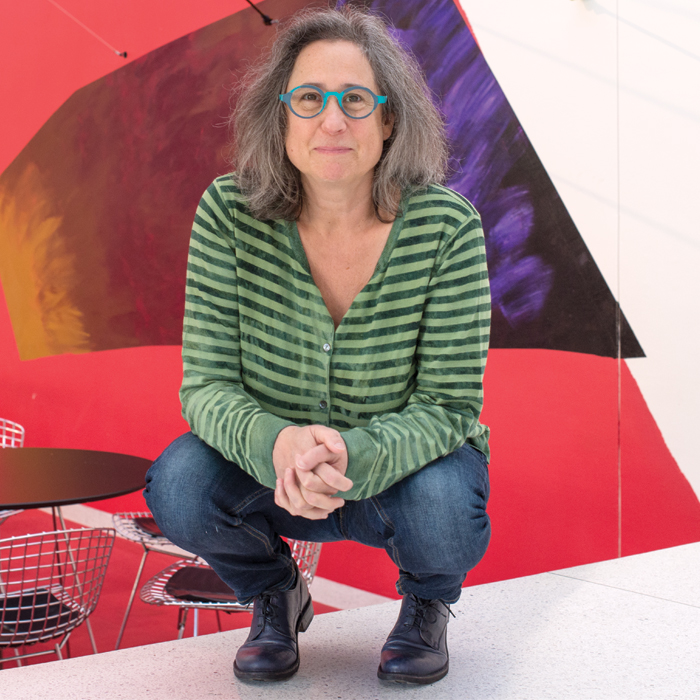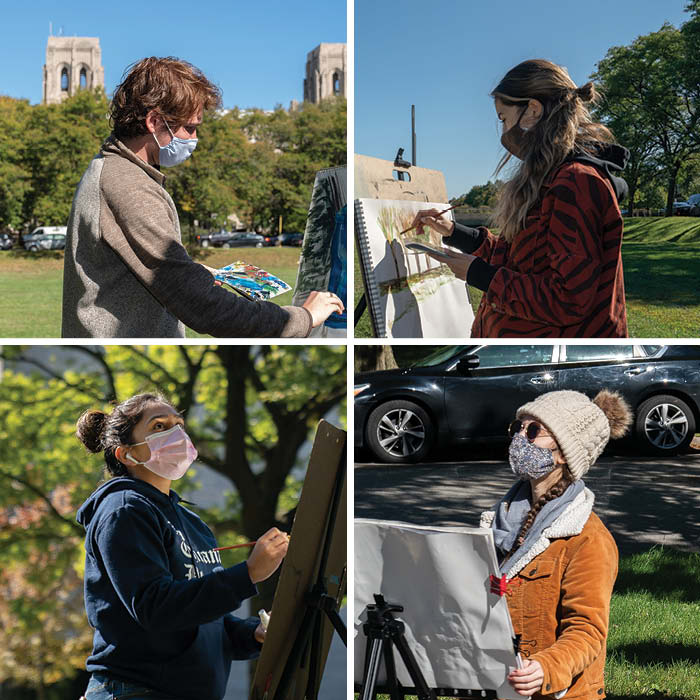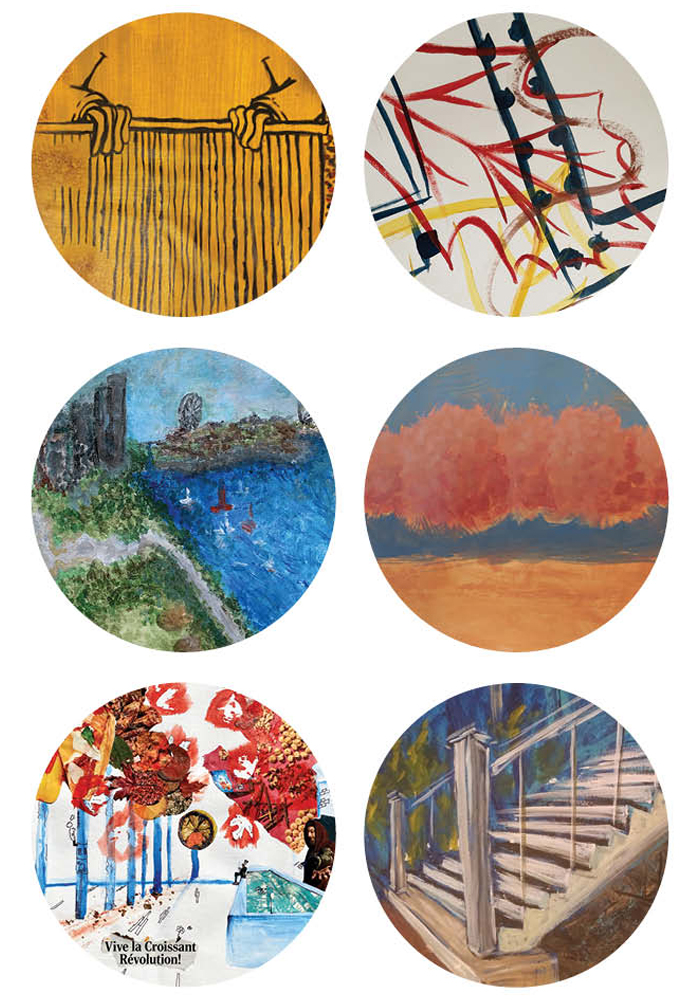
(Photography by Jason Smith)
During a quarter when everything was different, a professor known for installation art took her painting class outside.
Last quarter Jessica Stockholder was supposed to teach the course Painting Matters. When COVID-19 upended everything, Stockholder, the Raymond W. and Martha Hilpert Gruner Distinguished Service Professor of Visual Arts, had the idea of adapting her syllabus for an open-air painting course.
At the beginning of Autumn Quarter, the College offered three-week intensive courses—the equivalent of a standard 10-week course. “It struck me,” says Stockholder, “that an en plein air class would work for that three-week period, when the weather might accommodate it.”
Her adapted course, Painting Matters: En Plein Air, met in the morning until noon, three times a week. During the first week, when all College classes were remote, students painted at home. For the in-person classes, they gathered at the Logan Center, then found a spot to paint on the Midway. Most of the 14 students were nonmajors, though they all had taken a painting course before.

Traditional landscape paintings, created from observation, are not the type of work that Stockholder is known for—although sometimes she does create work that involves the outdoors. For an early piece, My Father’s Backyard (1983), Stockholder hung a spray-painted mattress on the side of her father’s garage and mounted a cupboard door on the roof with chicken wire. In 2009 she created an installation, Flooded Chambers Maid, in New York’s Madison Square Park, that included a brightly colored triangular platform and blue rubber mulch. Office workers took breaks there, and the local children played on it. Some artists might not have appreciated that, but Stockholder “enjoyed the variety of audiences that intersected the work.”
In her site-specific installations Stockholder uses lots of paint, but she applies it “evenly and opaquely, as a housepainter would do it,” according to the monograph Jessica Stockholder (Phaidon Press, 1995). She had never taught a plein air class before, or even taken one. Nonetheless her students raved about the course and her teaching—“excellent,” “amazing,” “incredible”—and were deeply grateful, during this strange and unprecedented quarter, for the “break from isolation” and “the much-needed sunlight.”
The following interview with Stockholder has been edited and condensed.
How was your course different from a traditional plein air painting class?
It wasn’t focused on how to become a mimetic painter. About halfway through I said to my students, you might be wondering what the course has to do with landscape, given the assignments. The assignments were very formal in nature, asking students to pay attention to the artifice of picture making.
When you move through life, you can’t notice everything. Consciousness is constructed to edit our perceptions. So art is an opportunity to slow down and ask questions about the editing. Why do we edit, and how do we edit?
I’m interested in visuality and how thinking and ideas are formally related to embodied experience. In the fall, the landscape changes so quickly. All the trees were changing color. It was a way of being in time, collectively, and noticing that shift. I hadn’t foreseen that, but it was really lovely.
What was the hardest thing about teaching the course?
It was difficult—and at a distance, where they’re not all together—to challenge the students’ preconceptions of what plein air painting should be.
When you are in a classroom gathered together, it’s like parallel play among babies. Babies don’t talk to each other, but they are very responsive to each other. An art classroom is like that. The students are always seeing what the others are doing and in this way they learn from each other. So that’s a real loss in this COVID moment.
Do you tell the students about your own work, or assume they’re going to google?
I don’t usually; only if they ask. I tell them I really love color, because I do.
I don’t think they usually google me, actually. At the undergrad level, they’re swimming in such complications of their own.
For one at-home assignment, you had them tape a sheet of acetate on a window and draw on it.
I learned that from Laura Letinsky [professor of visual arts]. She uses it in relation to photography.
The acetate frames a view. Then, with a marker, you draw what you’re seeing. But of course, if you move even a fraction of an inch, everything changes. And each of your eyes sees something different. Many of the students ended up using just one eye.
It’s an assignment that lets you see that realistic depictions—what we call realistic depictions—have nothing to do with how we actually see the world. You’re always seeing the world with two eyes, so your point of view is already multiple, and no one stays absolutely still without moving their head a fraction. You’re always putting together a whole bunch of views of the world.

During one of the outdoor sessions, you had students lay down a background color. Some chose really bright backgrounds, like hot pink. That seems challenging, to start with a color that’s not even in the landscape.
It’s arbitrary to start with a white background, and it’s a very traditional practice in oil painting to start with a background color. It’s not usually a bright color. It’s usually a more subdued color that inflects the painting moving forward.
What happened in this class—it’s always challenging to order materials—the students needed to be able to carry their materials, so they each had a set of small tubes. I realized they were all leaving lots of white in their paintings as they were being very careful about not using too much paint. They didn’t say that to me; I could just see it.
So we found some huge leftover bottles of paint at the Logan Center. That’s where the bright backgrounds came from. They no longer had to conserve paint.
What was the mood of the class like?
I think there was a sort of mellow sadness. But they were all very present and involved and worked hard.
During the final critique, which was remote, you mentioned how different art looks on-screen. You can’t see the brushwork at all, and the colors are different for everyone, depending on their screens.
Entirely different. That’s always a problem teaching art. At least they usually get to see each other’s work. But teaching about the history of art and trying to share contemporary work with them—right now you can’t even ask them to go to a museum. That’s not a fair ask.
Were there any unexpected challenges, beyond the initial lack of paint?
I didn’t really think through what we would do if the weather was horrific. I imagined an intrepid group of students who would be out there rain or shine.
But one student had really poor circulation and one day it was so cold, she asked if she could leave early. When I polled them about how they felt about working in the rain, they didn’t seem too excited.
I am a little allergic in the fall. Not obviously—not like sneezing and coughing allergic. But there was a lot of mold the last week. At the end of three hours of being outside, the rest of the day was gone for me.
But you would teach it again?
Oh yeah. In non-COVID times, it would be really great to teach it again, and be able to move in and out of the Logan Center easily—use the classroom and be outside. The students could store things and work there after class.

Artist statements
Students explain their work.
Top row
Timnah Rosenshine, Class of 2022: “This painting was a study on scale. It was one of the more challenging assignments of the quarter—to both represent scale and invert it.” For the same assignment, Tess Teodoro, Class of 2021, focused on the Logan Center and leaves, “flattening both objects into 2D line drawings, overlaid upon one another, in hypersaturated versions of the colors.”
Middle row
Defne Anlas, Class of 2021, painted “one of my favorite views in Chicago, Grant Park overlooking the skyline. I wanted to experiment with points and textures.” An abstract piece by Mercedes Cardenas, Class of 2021, was inspired by the trees on the Midway. She omitted their trunks, creating a “floating line of what looked like cotton candy.” (The full painting is this issue’s the cover.)
Bottom row
M. J. Harvey, Class of 2021, had fun “messing with perspective by combining two and three dimensions. The most challenging thing about creating this collage was stopping the process—I kept wanting to add more elements.” Perri Wilson, Class of 2021, painted the stairs of Taft House. “Since we had to paint a few quick pieces that day, I had to rush and couldn’t overthink,” she says. “I liked how unstable the final product turned out, like the stairs might blow away.”
